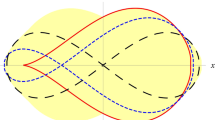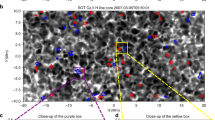Abstract
THE solar chromosphere, which separates the photosphere (temperature T ≈ 6,400 K) from the hotter solar corona (T ≈ 106 K), has a very inhomogeneous structure which is strongly influenced by the magnetic field. In the lowest 2,000 km of chromospheric altitude, the density falls by six orders of magnitude, and the temperature stays below 8,000 K. Above this altitude the transition to the corona is extremely irregular. It is dominated by spicules: thin (< 1,000 km) protrusions of cool chromospheric material which extend, with speeds of 25 km s−1 and for durations of 5–10 min, up to 10,000 km into the corona with little change in density. Their origin is not yet understood, and I suggest here that the force that propels them against gravity may be the transfer of momentum from upward-moving Alfvén waves. In the upper chromosphere the ionized plasma component is collisionally coupled to the neutral gas, but the coupling is not perfect, so that the neutral material can acquire a net velocity with respect to the ionized component. This process is known to damp the Alfvén waves12, but I show that it can also, as the chromosphere peters out, transfer enough momentum to local volumes to create and drive the spicules.
This is a preview of subscription content, access via your institution
Access options
Subscribe to this journal
Receive 51 print issues and online access
$199.00 per year
only $3.90 per issue
Buy this article
- Purchase on Springer Link
- Instant access to full article PDF
Prices may be subject to local taxes which are calculated during checkout
Similar content being viewed by others
References
Parker, E. N. Astrophys. J. 140, 1170–1173 (1964).
Schlüter, A. IAU Symp. No. 4, Radio Astronomy (ed. van de Hulst, H. C.) 356–357 (Cambridge Univ. Press, 1957).
Parker, E. N. Astrophys. J. Suppl. 27, 51–76 (1957).
Bessey, R. J. & Kuperus, M. Solar Phys. 12, 216–228 (1970).
Uchida, Z. Publ. astr. Soc. Japan 21, 218–140 (1969).
Pikel'ner, S. B. Astr. Zh. 46, 328–336; Sov. Astr. Astrophys. J. 13, 259–266 (1969).
Sterling, A. C. & Hollweg, J. V. Astrophys. J. 327, 950–963 (1988).
Kopp, R. A. & Kuperus, M. Solar Phys. 4, 212–223 (1968).
Priest, E. Solar Magnetohydrodynamics (Reidel, Dordrecht, 1982).
Athay, R. G. in Physics of the Sun Vol. II (ed. Sturrock, P. A. et al.) 51–69 (Reidel, Dordrecht, 1986).
Foukal, P. V. Solar Astrophysics (Wiley, New York, 1990).
Piddington, J. H. Mon. Not. R. astr. Soc. 116, 314–323 (1956).
Osterbrock, D. E. Astrophys. J. 134, 347–388 (1961).
Dungey, J. W. Cosmic Electrodynamics (Cambridge Univ. Press, 1958).
Hasegawa, A. & Uberoi, C. The Alfvén Wave (DOE, Springfield, Virginia, 1982).
Beckers, J. M. A. Rev. Astr. Astrophys. 10, 73–100 (1972).
Vernazza, J. E., Avrett, E. H. & Loeser, R. Astrophys. J. Suppl. 45, 635–725 (1981).
McWhirter, R. W. P., Thonemann, P. C. & Wilson, R. Astr. Astrophys. 40, 63–73 (1975).
Peres, G., Rosner, R., Serio, S. & Vaiana, G. S. Astrophys. J. 252, 791–799 (1982).
Author information
Authors and Affiliations
Rights and permissions
About this article
Cite this article
Haerendel, G. Weakly damped Alfvén waves as drivers of solar chromospheric spicules. Nature 360, 241–243 (1992). https://doi.org/10.1038/360241a0
Received:
Accepted:
Issue Date:
DOI: https://doi.org/10.1038/360241a0
This article is cited by
-
Alfvénic waves in the inhomogeneous solar atmosphere
Reviews of Modern Plasma Physics (2023)
-
Polymeric jets throw light on the origin and nature of the forest of solar spicules
Nature Physics (2022)
-
Partially Ionized Plasmas in Astrophysics
Space Science Reviews (2018)
-
Quasi-periodic variations in Doppler velocities of Hα spicules
Astrophysics and Space Science (2014)
-
Prominence Seismology Using Small Amplitude Oscillations
Space Science Reviews (2009)
Comments
By submitting a comment you agree to abide by our Terms and Community Guidelines. If you find something abusive or that does not comply with our terms or guidelines please flag it as inappropriate.



